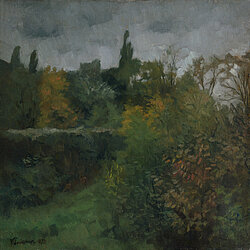Loading the page ...
Wilhelm Trübner
1851 Heidelberg – 1917 Karlsruhe
In the 1870s, Wilhelm Trübner – together with Wilhelm Leibl, Carl Schuch and Johannes Sperl – was considered one of the foremost representatives of an uncompromising and unorthodox style of plein-air painting that was openly at odds with the academic approach to art at the time. After studying at the Karlsruhe Academy, where he was greatly influenced by his teacher Hans Canon, a painter from Vienna, Trübner went to Munich in 1869 and enrolled in the Academy there. His artistic development was advanced considerably by his exposure to the paintings of Wilhelm Leibl and Gustave Courbet, whose works he saw at the art exhibition in the Glass Palace in Munich the same year. Trübner subsequently became an advocate of emphatic Naturalism, his convictions being strengthened by his contacts with like-minded artists such as Albert Lang and Carl Schuch. Having finally met Wilhelm Leibl in Bernried in the summer of 1871, Trübner decided to join his circle. While their relationship was rooted in mutual recognition, the two artists nonetheless maintained a respectful distance from each other.
Archive
